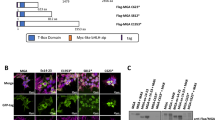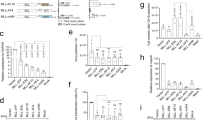Abstract
The t(2;13) and t(1;13) translocations of alveolar rhabdomyosarcoma (ARMS) result in chimeric PAX3-FKHR or PAX7-FKHR transcription factors, respect-ively. In each chimera, a PAX DNA-binding domain is fused to the C-terminal FKHR transactivation domain. Previously we demonstrated that PAX3-FKHR is more potent than PAX3 because the FKHR transactivation domain is resistant to repression mediated by the PAX3 N-terminus. Here we test the hypothesis that the cis-acting repression domain is a conserved feature of PAX3 and PAX7 and that PAX7-FKHR gains function similarly. Using PAX-specific DNA-binding sites, we found that PAX7 was virtually inactive, while PAX7-FKHR exhibited activity 600-fold above background and was comparable to PAX3-FKHR. Deletion analysis showed that the transactivation domains of PAX7 and PAX7-FKHR are each more potent than either full-length protein, and resistance to cis-repression is responsible for the PAX7-FKHR gain of function. Further deletion mapping and domain swapping experiments with PAX3 and PAX7 showed that their transactivation domains exhibit subtle dose-dependent differences in potency, likely due to regions of structural divergence; while their repression domains are structurally and functionally conserved. Thus, the data support the hypothesis and demonstrate that PAX3 and PAX7 utilize a common gain of function mechanism in ARMS.
This is a preview of subscription content, access via your institution
Access options
Subscribe to this journal
Receive 50 print issues and online access
$259.00 per year
only $5.18 per issue
Buy this article
- Purchase on Springer Link
- Instant access to full article PDF
Prices may be subject to local taxes which are calculated during checkout






Similar content being viewed by others
Abbreviations
- ARMS:
-
alveolar rhabdomyosarcoma
- CAT:
-
chloramphenicol acetyltransferase
- PCR:
-
polymerase chain reaction
References
Barr FG. . 1997 Curr. Top. Microbiol. Immunol. 220: 113–129.
Barr FG, Chatten J, D'Cruz CM, Wilson AE, Nauta LE, Nycum LM, Biegel JA and Womer RB. . 1995 Jama 273: 553–557.
Bennicelli JL, Edwards RH and Barr FG. . 1996 Proc. Natl. Acad. Sci. USA 93: 5455–5459.
Bennicelli JL, Fredericks WJ, Wilson RB, Rauscher III FJ and Barr FG. . 1995 Oncogene 11: 119–130.
Burri M, Tromvoukis Y, Bopp D, Frigerio G and Noll M. . 1989 EMBO J. 8: 1183–1190.
Busslinger M, Klix N, Pfeffer P, Graininger PG and Kozmik Z. . 1996 Proc. Natl. Acad. Sci. USA 93: 6129–6134.
Chalepakis G, Fritsch R, Fickenscher H, Deutsch U, Goulding M and Gruss P. . 1991 Cell 66: 873–884.
Clark J, Benjamin H, Gill S, Sidhar S, Goodwin G, Crew J, Gusterson BA, Shipley J and Cooper CS. . 1996 Oncogene 12: 229–235.
Davis RJ and Barr FG. . 1997 Proc. Natl. Acad. Sci. USA 94: 8047–8051.
Davis RJ, D'Cruz CM, Lovell MA, Biegel JA and Barr FG. . 1994 Cancer Res. 54: 2869–2872.
Fredericks WJ, Galili N, Mukhopadhyay S, Rovera G, Bennicelli J, Barr FG and Rauscher III FJ. . 1995 Mol. Cell. Biol. 15: 1522–1535.
Frigerio G, Burri M, Bopp D, Baumgartner S and Noll M. . 1986 Cell 47: 735–746.
Fujimura Y, Ohno T, Siddique H, Lee L, Rao VN and Reddy ES. . 1996 Oncogene 12: 159–167.
Gorman CM, Moffat LF and Howard BH. . 1982 Mol. Cell. Biol. 2: 1044–1051.
Henthorn P, Zervos P, Raducha M, Harris H and Kadesch T. . 1988 Proc. Natl. Acad. Sci. USA 85: 6342–6346.
Kaz K, Voz ML, Roijer E, Astrom AK, Meyen E, Stenman G and Van de Ven WJ. . 1997 Nat. Genet. 15: 170–174.
Kelly KM, Womer RB, Sorensen PH, Xiong QB and Barr FG. . 1997 J. Clin. Oncol. 15: 1831–1836.
Kim J, Lee K and Pelletier J. . 1998 Oncogene 16: 1973–1979.
Ladanyi M. . 1995 Diagn. Mol. Pathol. 4: 162–173.
Li X and Noll M. . 1994 Nature 367: 83–87.
Lillie JW and Green MR. . 1989 Nature 338: 39–44.
May WA, Lessnick SL, Braun BS, Klemsz M, Lewis BC, Lunsford LB, Hromas R and Denny CT. . 1993 Mol. Cell. Biol. 13: 7393–7398.
Schäfer BW, Czerny T, Bernasconi M, Genini M and Busslinger M. . 1994 Nucleic. Acids. Res. 22: 4574–4582.
Scheidler S, Fredericks WJ, Rauscher III FJ, Barr FG and Vogt PK. . 1996 Proc. Natl. Acad. Sci. USA 93: 9805–9809.
Sorensen PH and Triche TJ. . 1996 Semin. Cancer Biol. 7: 3–14.
Tremblay P and Gruss P. . 1994 Pharmacol. Ther. 61: 205–226.
Vorobyov E, Mertsalov I, Dockhorn-Dworniczak B, Dworniczak B and Horst J. . 1997 Genomics 45: 168–174.
Wiggan O, Taniguchi-Sidle A and Hamel PA. . 1988 Oncogene 16: 227–236.
Xue L and Noll M. . 1996 EMBO J. 15: 3722–3731.
Zinszner H, Albalat R and Ron D. . 1994 Genes Dev. 8: 2513–2526.
Acknowledgements
We would like to thank Paul Pelavin and Rob McDonald for their technical assistance. These studies were supported by National Institutes of Health grant CA64202.
Author information
Authors and Affiliations
Rights and permissions
About this article
Cite this article
Bennicelli, J., Advani, S., Schäfer, B. et al. PAX3 and PAX7 exhibit conserved cis-acting transcription repression domains and utilize a common gain of function mechanism in alveolar rhabdomyosarcoma. Oncogene 18, 4348–4356 (1999). https://doi.org/10.1038/sj.onc.1202812
Received:
Revised:
Accepted:
Published:
Issue Date:
DOI: https://doi.org/10.1038/sj.onc.1202812
Keywords
This article is cited by
-
Acetylation of PAX7 controls muscle stem cell self-renewal and differentiation potential in mice
Nature Communications (2021)
-
Establishment and characterization of a novel alveolar rhabdomyosarcoma cell line, NCC-aRMS1-C1
Human Cell (2020)
-
Rhabdomyosarcoma
Nature Reviews Disease Primers (2019)
-
Oncorhynchus mykiss pax7 sequence variations with comparative analyses against other teleost species
SpringerPlus (2015)
-
Alveolar rhabdomyosarcoma-associated proteins PAX3/FOXO1A and PAX7/FOXO1A suppress the transcriptional activity of MyoD-target genes in muscle stem cells
Oncogene (2013)



